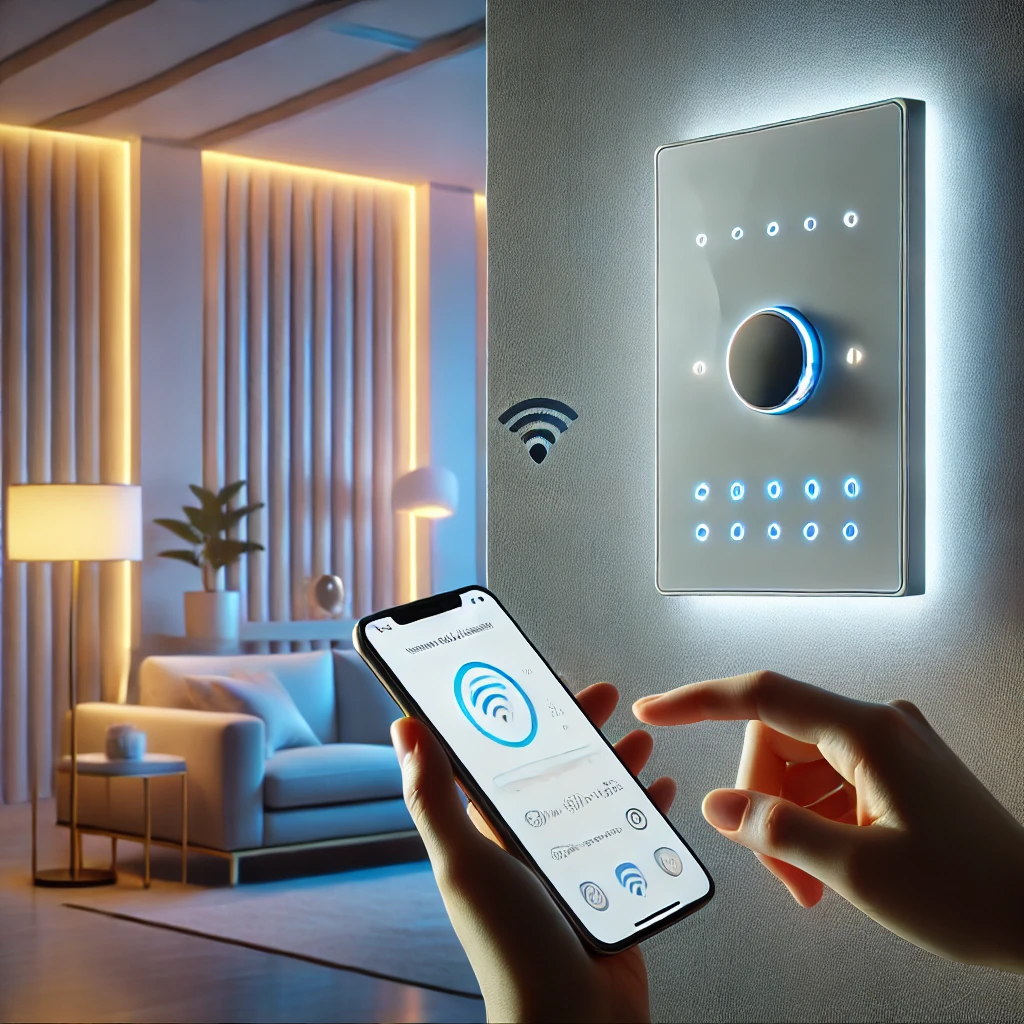Modern households face a revolution with home automation while smart light switches represent the most practical home improvement choice. These contemporary lighting solutions enable distance control of home illumination together with automatic schedules and Apple Siri and Amazon Alexa compatibility. A smart light switch needs to be mandatory in every smart home setup because it offers benefits related to convenience and energy efficiency along with security protection.
What is a Smart Light Switch?
The smart light switch operates as a state-of-the-art device designed for remote control and scheduling functions as well as automated lighting preference activation. Smart switches go beyond normal devices because they join Wi-Fi networks or smart hub platforms which permits users to operate them by applications or voice commands or through automated systems.
Individual Features Found in Smart Light Switches Include:
- The smartphone application allows users full control over lighting regardless of their physical location.
- A smart lighting control device which enables operation under the commands of Alexa and Google Assistant and Siri.
- The feature of customizable schedules allows automated lighting activation through predefined routines.
- The technology helps households diminish their electricity consumption.
- The system allows users to edit illumination levels through its dimming feature.
- The smart switch runs autonomously by sensing human movement because of its built-in motion detection system.
- Multi-Device Synchronization – Connects with other smart home devices.
How Does a Smart Light Switch Work?
The Wi-Fi or smart home hub connected smart light switch enables remote control of the device. Here’s how it works:
- Installation – Replace your existing switch with a smart light switch.
- Wi-Fi or Hub Connection – Connect the switch to a Wi-Fi network or a smart hub like SmartThings.
- Users can establish automation through their mobile application’s configuration settings.
- Your smart light switch can connect to voice assistants through the Voice Control integration to function without hands.
- Automation & Scheduling – Set timers, routines, and automation for different lighting scenarios.
Benefits of Installing a Smart Light Switch
Smart lighting offers multiple advantages beyond just convenience. Smart light switches provide several beneficial features that make them excellent choices for home upgrades because of the following advantages.
1. Convenience & Remote Control
- Users of smartphones and tablets can control lights.
- Your home remains protected from power wastage even if you forget to switch off lights during your absence.
2. Energy Efficiency & Cost Savings
- Customers can save on their electricity costs through automatic lighting regulation.
- The installation of motion sensors enables automatic light switch-off during unused periods.
- The dimming feature enables brightness reduction which leads to energy savings.
3. Enhanced Security & Safety
- The system can imitate home presence through scheduled light operations.
- Your security system can connect and trigger automatic responses through its network.
- Outside lighting becomes more visible when sensors detect motion during the night hours.
4. Users can integrate Voice Command feature and Smart Home Automation through this system.
- Works with Amazon Alexa, Google Assistant, and Apple HomeKit.
- The system forms a complete integration with smart home devices including both cameras and thermostats and door locks together.
5. Customizable Ambiance & Mood Settings
- Users can modify lighting intensity based on entertainment needs and reading tasks as well as casual relaxation periods.
- Bulbs with color-changing technology should be programmed to match different atmospheres when compatible.
Types of Smart Light Switches
The selection of a smart light switch should match your home configuration along with its specific needs. The following list showcases all the main smart switch types available on the market:
1. Wi-Fi Smart Light Switch
- This product links to home Wi-Fi networks without needing any additional hub setup.
- Controlled via mobile apps and voice assistants.
2. Zigbee or Z-Wave Smart Light Switch
- A compatible hub between Samsung SmartThings or Hubitat needs to be present for installation.
- The smart home automation system functions better when connected through this device.
3. Bluetooth Smart Light Switch
A smartphone can pair with this device though its operating range stays restricted. Ideal for single-room control.
4. Touchscreen & Panel-Based Smart Switches
- Modern, stylish designs with touch-sensitive controls.
- The additional features of these switches might include built-in dimmer settings and framework options.
Users can refer to this guide for installing a smart light switch at their home.
A person needs fundamental electrical understanding to properly install a smart light switch. To perform a successful setup follow the described procedures.
Step 1: Turn Off Power
Turn off electrical power at the main circuit breaker point prior to installation.
Step 2: Remove the Old Switch
You should carefully remove and disconnect the wires which run to your standard switch.
Step 3: Connect the Smart Switch
Follow the manufacturer’s guide to properly connect the wires between the neutral, load, live and ground terminals.
Step 4: Secure & Mount
- Securely mount the smart switch within the wall box.
- The fifth step involves linking your Smart Switch to both Wi-Fi service and Smart Hub.
- The application program shows you how to link your network to the switch.
Step 5: Test & Automate
- Turn the power on before conducting the switch test while you activate the automation features.
- The decision between using a smart light switch or smart bulbs depends on which option provides better functionality.
- The difference exists between these two devices since they deliver distinct functions that benefit home automation.
| Feature | Smart Light Switch | Smart Bulbs |
| Control Method | Wall switch, app, voice | App, voice, switch |
| Installation | Replaces traditional switch | Screws into lamp/socket |
| Dimming Feature | Available on some models | Available on most models |
| Works with Traditional Bulbs? | Yes | No |
| Best For | Whole-home automation | Individual lamp control |
Future of Smart Light Switches
The advancement of technology will make smart light switches more advanced in terms of both devices functionality and user experience. Upcoming innovations include:
1. AI-Powered Smart Lighting
- These algorithms will acquire household practices to produce automatic system modifications.
- Voice assistants will supply automatic lighting recommendations to users.
2. Gesture & Touch-Free Control
- People will see increasingly prevalent use of lights controlled by movement and voice commands.
- Touch-free operation for hygiene-conscious environments.
3. Enhanced Energy Monitoring
- Smart switches will display live electricity consumption records to users.
- Through AI-based recommendations the house can achieve decreased energy consumption.
4. Integration with Smart Cities
- Future versions of smart switches will establish interconnectivity with smart city energy systems.
- The users will achieve lighting optimization by following energy demand trends.
Conclusion
Smart light switches offer users the advantage of improved home functionality while increasing residential safety levels while reducing energy expenses. Smart light switches offer three operating features that include mobile app control and voice-command operation and automated lighting functions which will enhance your living environment. Smart switches will maintain increasing importance in future smart homes because of advancing technology developments. An intelligent lighting control upgrade today will unveil all its valuable benefits.





